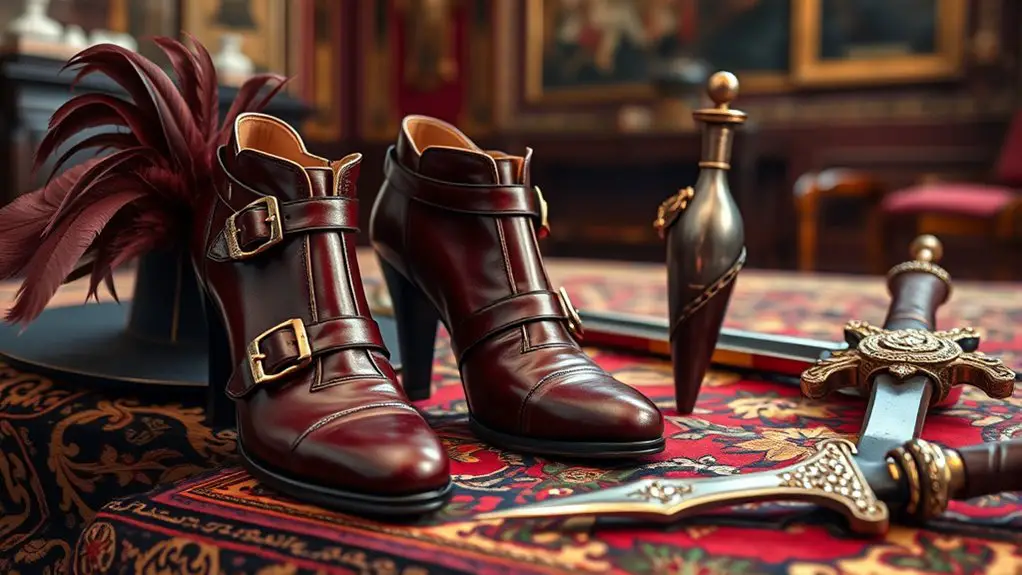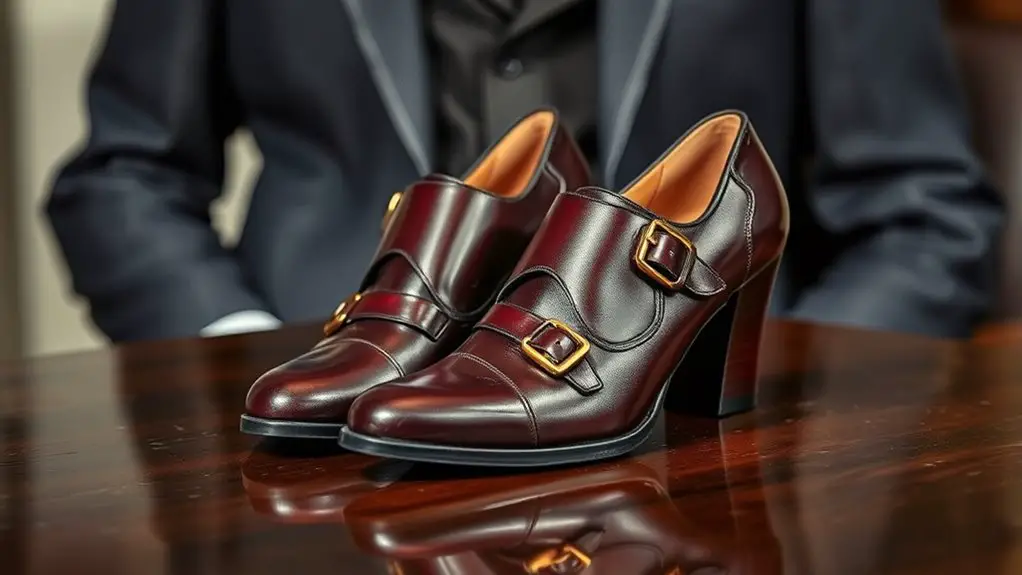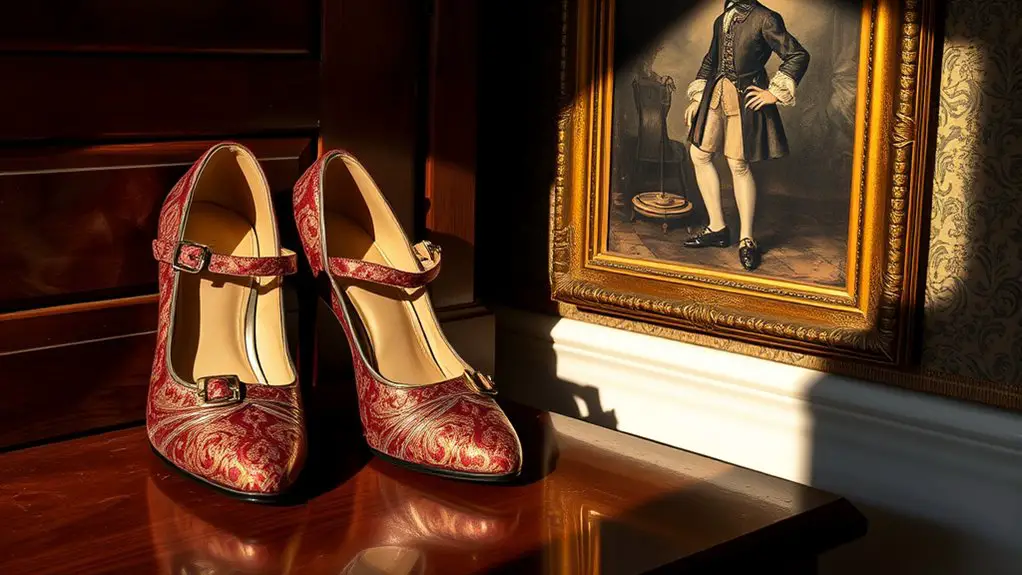High heels originated in the 16th century as practical footwear for men. They enhanced stability while riding horses and elevated a man’s stature in social settings. As symbols of power and authority, high heels conveyed dominance in both military and aristocratic circles. Over time, they shifted into women’s fashion, becoming linked to femininity and allure. The evolution of high heels reflects broader societal changes, and there’s much more to explore about their impact on fashion today.
The Origins of High Heels in the 16th Century

High heels, often associated with women’s fashion today, have surprising roots in the 16th century when they were primarily worn by men. Back then, high heels were not merely a style choice; they served practical purposes, particularly in 16th century footwear. Men of the aristocracy wore them to elevate their stature, both literally and figuratively, as higher heels were seen as a sign of wealth and power.
The cultural significance of high heels during this period cannot be overstated. They symbolized social status and confidence, allowing men to assert their dominance in a rapidly changing world. The heels also provided a way to navigate muddy streets, showcasing a blend of fashion and functionality. As you explore the history of high heels, you’ll uncover how these shoes shifted from male-centric fashion statements to the women’s fashion staples we recognize today, reflecting broader societal shifts in gender and style.
High Heels as a Symbol of Power and Status
High heels have long been more than just a fashion choice; they’ve served as powerful symbols of status and authority. Originating in the 16th century, these elevated shoes reflected aristocratic ideals and military prowess, making them a statement of dominance in both social and political spheres. As you explore this evolution, consider how the perception of high heels has shifted and what it reveals about societal values.
Historical Origins of Heels
Although many associate high heels with femininity today, their origins reveal a fascinating narrative of power and status that transcended gender. In the 15th century, high heels were a staple in men’s historical footwear, symbolizing nobility and dominance. As you explore their cultural significance, you’ll find that the elevated stature provided by heels conveyed authority, making wearers appear taller and more imposing. Persian cavalrymen first donned these shoes for stability during horseback riding, but they soon became fashionable among European aristocrats. This shift marked a transformation where high heels became a visual cue of wealth and social standing, challenging modern perceptions. Understanding these historical roots allows you to appreciate how footwear has long been intertwined with identity and power.
Aristocratic Fashion Statements
The evolution of high heels into a fashion statement among the aristocracy illustrates their role as a symbol of power and status in society. Originally, high heels represented aristocratic privilege, allowing those who wore them to rise above the common populace, both literally and figuratively. In a rigid fashion hierarchy, the height of one’s heel often signaled wealth and influence, differentiating the elite from the lower classes. As you navigate historical portraits and court scenes, you’ll notice that these elevated shoes were not just about aesthetics; they communicated dominance and social rank. The more extravagant the heel, the stronger the assertion of status, reinforcing the notion that fashion was, and still is, intertwined with power dynamics in society.
Military Influence on Style
While many associate high heels with femininity and fashion, their origins in the military reveal a deeper connection to power and authority. Historically, military aesthetics played a significant role in shaping the design of high heels, as they were initially crafted to enhance stature and assert dominance on the battlefield. The functionality of heels allowed soldiers to stay firmly planted in their stirrups, lending stability during combat. This symbolic elevation became a visual cue of rank and status, making high heels a tool of power. As you explore the evolution of high heels, it’s clear that their military roots reflect a complex interplay between style and authority, transcending mere fashion to embody a legacy of strength and command.
Practical Uses of High Heels for Men
Though often perceived as purely a fashion statement today, high heels originally served practical purposes for men, enhancing both their stature and functionality. Historically, high heels provided men with added height, which was advantageous in various social and military contexts. This elevation not only conveyed authority but also improved visibility in crowded spaces.
In addition to aesthetics, high heels had practical applications related to riding. The elevated heel helped secure a rider’s foot in the stirrup, offering stability when maneuvering through challenging terrains.
Contemporary usage of high heels by men, though less common, can still reflect a blend of style and purpose. Some modern designs prioritize comfort and support, making them suitable for long events or social gatherings. By recognizing their historical significance, you can appreciate high heels as more than a trend—they’re a unique intersection of utility and style that transcends gender norms.
The Transition to Women’s Fashion

As high heels evolved in the fashion landscape, their association with masculinity began to wane, paving the way for women’s fashion to embrace this once-male accessory. The late 17th century marked a significant shift; as women adopted heels, they transformed them into symbols of femininity and allure. This change wasn’t just about aesthetics—it was a pivotal moment in the fashion revolution, signaling a newfound expression of female empowerment.
High heels became a way for women to assert their presence in a male-dominated society. With each step taken in stilettos, women reclaimed an accessory that had once been theirs to begin with. The evolution of high heels into women’s fashion reflected broader societal changes, where personal style became an avenue for self-expression. By embracing high heels, women not only embraced beauty but also challenged norms, redefining what it meant to be fashionable and powerful.
High Heels in the 19th and 20th Centuries
High heels underwent a remarkable evolution in the 19th and 20th centuries, evolving from symbols of aristocracy to expressions of modern femininity. In the 19th century, trends reflected a society obsessed with social class; heels became a status symbol among the wealthy elite, often adorned with elaborate designs. However, as the century progressed, practicality began to influence fashion, leading to shorter, more functional styles.
By the 20th century, styles took on a revolutionary flair. Heels became an essential part of women’s wardrobes, symbolizing empowerment and independence. Iconic figures like Marilyn Monroe popularized stiletto heels, which emphasized femininity and allure. The post-war era saw heels diversify, reflecting cultural shifts and the rise of youth culture.
Ultimately, high heels transformed into a form of self-expression, mirroring broader societal changes and reshaping how you perceive femininity and power in fashion.
The Modern Interpretation of High Heels

As you explore the modern interpretation of high heels, consider how fashion trends have evolved to reflect shifting gender norms. What was once a symbol of male power has transformed into a complex statement about femininity and identity. Today, high heels can signify everything from empowerment to societal pressure, prompting you to question their role in contemporary culture.
Fashion Trends Evolution
While the history of high heels reveals their origins in masculinity, today’s fashion landscape showcases a remarkable evolution that redefines their significance. High heels now symbolize empowerment and individuality, influenced by shifting societal norms and fashion evolution. Here are three ways modern interpretations have transformed high heels:
- Diversity in Styles: From stilettos to chunky platforms, there’s a high heel for every personality and occasion.
- Inclusivity: Brands are increasingly offering sizes and designs catering to all body types, breaking traditional beauty standards.
- Comfort Innovations: Advances in materials and design prioritize comfort without sacrificing style, making high heels more accessible.
These trends highlight how societal influences continue to reshape the narrative surrounding high heels, making them a versatile fashion statement in today’s world.
Gender Norms Shift
Though often associated with femininity, high heels have become a canvas for challenging and redefining gender norms in contemporary fashion. As social expectations evolve, you’ll notice a growing acceptance of men wearing heels, pushing boundaries and promoting gender fluidity. This shift is a reflection of broader gender evolution, where traditional roles are questioned and reimagined. Designers now create styles that cater to all genders, emphasizing personal expression over conformity. You’re witnessing a remarkable change in how high heels are perceived—no longer just a symbol of femininity, but a statement of individuality. As more people embrace this versatility, high heels symbolize a rebellion against outdated norms, creating space for diverse identities to flourish in fashion.
Frequently Asked Questions
Did High Heels Have Any Impact on Social Class Distinctions?
High heels have considerably influenced social hierarchy, serving as a fashion statement that distinguishes social classes. They’ve symbolized wealth and status, with their evolution reflecting changing perceptions of power and femininity within society.
What Materials Were Originally Used to Make High Heels?
When you explore the origins of high heels, you’ll find they were crafted from various leather types, with heel heights varying for functionality and style. These materials not only shaped aesthetics but also defined social standing.
How Did High Heels Affect Men’s Posture and Walking?
High heels greatly influenced men’s posture alignment and walking style. By elevating the heel, they shifted weight forward, promoting an upright stance and altering gait. This change enhanced both confidence and presence in social and professional settings.
Were High Heels Popular in Any Specific Cultures or Regions?
High heels have cultural significance across various regions, particularly in Europe, where they symbolized status. Regional variations reflect differing styles and purposes, showcasing how fashion intertwines with cultural identity and societal norms throughout history.
What Were the Initial Reactions to Men Wearing High Heels?
Initially, reactions to men in high heels varied; some embraced the bold fashion evolution, challenging gender expectations, while others criticized it. This tension reflects society’s shifting views on masculinity and personal expression through clothing choices.



